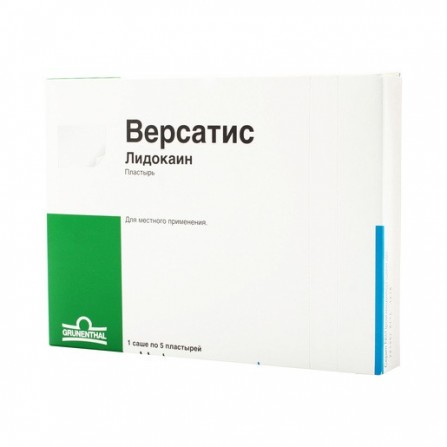Versatis plaster tdts sachet N5
Condition: New product
1000 Items
Rating:
Be the first to write a review!

More info
Active ingredients
Lidocaine
Release form
Patch
Composition
1 patch contains: Lidocaine 700 mg Auxiliary substances: purified water - 3367 mg, glycerol - 2520 mg, sorbitol - 2800 mg, polyacrylic acid (20% solution) - 1400 mg, sodium polyacrylate 400-600 mPa.s - 700 mg, carmellose sodium 90-168 mPa.s - 700 mg, propylene glycol - 700 mg, urea - 420 mg, kaolin - 210 mg, tartaric acid (tartaric) - 210 mg, gelatin - 147 mg, polyvinyl alcohol (75000) - 58.8 mg, aluminum dihydroxyaminoacetate (aluminum glycinate) - 32.2 mg, disodium edetate - 14 mg, methyl parahydroxybenzoate - 14 mg, propyl parahydroxybenzoate - 7 mg, nonwoven fabric - 1750 mg, plastic forging film (polyethylene terephthalate, PET) - 742 mg.
Pharmacological effect
Local anesthetic, acetamide derivative. Possesses membrane stabilizing activity, causes blockade of sodium channels of excitable neuronal membranes. When applied topically, it does not irritate the tissue, in recommended doses it does not affect myocardial contractility and does not slow down AV conductivity. When applied topically on intact skin, a therapeutic effect occurs, sufficient to relieve pain, without the development of a systemic effect.
Pharmacokinetics
Absorption The amount of lidocaine absorbed from the drug is 3 ± 2% of the total amount that is part of the TTC. At least 95% (665 mg) of lidocaine remains in the used TTC. With the application of 3 TTC for 12 hours, Cmax in the blood is 0.13 mcg / ml. The distribution of plasma protein binding is 50-80%. It is distributed quickly (T1 / 2 in the distribution phase - 6-9 min), first enters well-supplied blood, then into adipose and muscle tissues. It penetrates the BBB and placental barrier, is excreted in breast milk (up to 40% of the concentration in the mother's plasma). Metabolism and elimination Metabolized in the liver (90-95%) with the participation of microsomal enzymes with the formation of pharmacologically active metabolites. Excreted in the bile and kidneys (up to 10% - unchanged).
Indications
- pain syndrome with vertebral lesions; - myositis; - postherpetic neuralgia.
Contraindications
- violation of the integrity of the skin in the place of overlay TTC; - hypersensitivity to lidocaine and other components of the TTC.
Precautionary measures
It is used with caution in infectious or traumatic skin lesions at the site of overlap, in acute diseases, in debilitated patients, in children under 2 years of age, and in the elderly.
Use during pregnancy and lactation
Versatis should not be used during pregnancy and lactation (breastfeeding).
Dosage and administration
TTC is intended for topical use, it should be pasted on the skin to cover the pain surface above the affected area. After applying the system, avoid contact of hands with eyes, hands should be washed immediately. TTC can stay on the skin for 12 hours. Then TTC is removed and a 12-hour break is taken. You can stick up to three TTS at the same time. If you experience a burning sensation or redness of the skin during the use of TTS, you must remove the system and do not use TTC until the redness disappears. Used systems should be kept out of the reach of children or pets.
Side effects
Allergic reactions: allergic contact dermatitis (hyperemia at the site of application, skin rash, urticaria, pruritus), angioedema. Others: burning sensation at the site of application.
Overdose
An overdose of TTC is unlikely, but it is impossible to completely eliminate it, because improper use can lead to higher plasma concentrations than normal. Possible signs of systemic toxicity in this case will be similar in essence to those after the introduction of lidocaine in the form of a local anesthetic.
Interaction with other drugs
Since plasma lidocaine concentrations are very low, clinically significant drug interactions are unlikely. It should be used with caution in patients receiving class I antiarrhythmic drugs and other local anesthetics.
special instructions
In chronic renal failure, accumulation of metabolites is possible. Acidification of urine helps to increase the excretion of lidocaine. In liver diseases, the metabolic rate decreases and ranges from 50% to 10% of the normal value.




